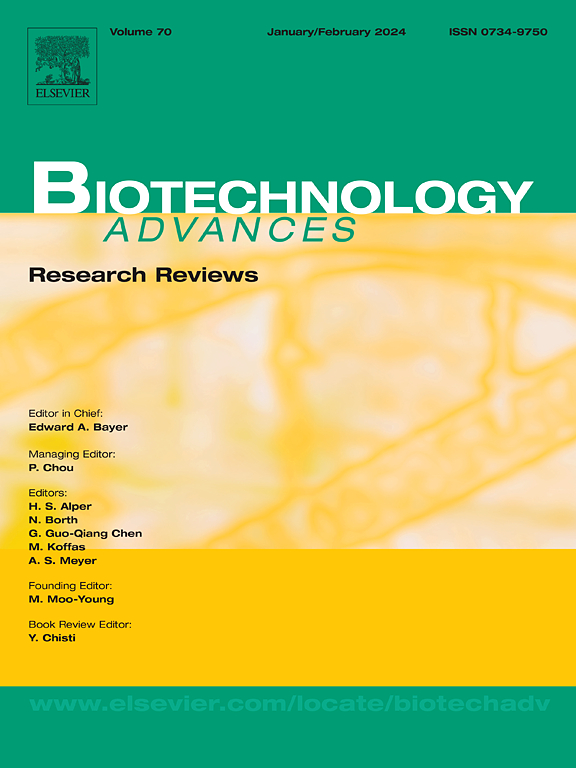Advances in molecular tools for parasitic nematodes of animals – From genetic markers to metabarcoding and genomics
IF 12.5
1区 工程技术
Q1 BIOTECHNOLOGY & APPLIED MICROBIOLOGY
引用次数: 0
Abstract
Parasitic nematodes are globally important pathogens of animals, humans and plants. The accurate identification and characterisation of these nematodes are essential for diagnostics, systematics and epidemiological surveillance. Over the past decades, molecular technologies have progressed from targeted PCR-based assays using nuclear ribosomal markers – particularly the first and second internal transcribed spacers (ITS-1 and ITS-2) – to high-throughput metabarcoding and genome-enabled approaches. These advances have transformed species discovery, facilitated the detection of cryptic taxa and supported the development of sensitive diagnostic tools for parasitic nematodes of veterinary, medical and agricultural importance. This review traces the progression of molecular technologies used to study parasitic nematodes, with emphasis on the definition and validation of ribosomal and mitochondrial DNA markers, metabarcoding frameworks, such as the “nemabiome”, and the expanding availability of genomic resources. Particular attention is given to the emergence of workflows and bioinformatic pipelines supporting primer evaluation, variant detection, taxonomic assignment and analyses of genetic diversity. The integration of curated reference databases, multi-marker strategies and advanced informatics has allowed for scalable, reproducible and high-resolution investigations of nematode diversity. Recent innovations in long-read sequencing and CRISPR-based enrichment, which may enable amplification-free, multi-locus profiling of nematode communities, are also highlighted. Collectively, these advances in molecular and genomic technologies – underpinned by reproducible informatic frameworks – are transforming the systematics, diagnostics and epidemiological surveillance of parasitic nematodes of animals.
动物寄生线虫分子工具研究进展——从遗传标记到元条形码和基因组学。
寄生线虫是全球重要的动物、人类和植物病原体。这些线虫的准确鉴定和特征对于诊断、系统分类和流行病学监测至关重要。在过去的几十年里,分子技术已经从使用核糖体标记物(特别是第一和第二内部转录间隔物(ITS-1和ITS-2))的靶向pcr检测发展到高通量元条形码和基因组支持方法。这些进展改变了物种发现,促进了隐蔽分类群的检测,并支持开发对兽医、医疗和农业具有重要意义的寄生线虫的敏感诊断工具。本文回顾了用于研究寄生线虫的分子技术的进展,重点介绍了核糖体和线粒体DNA标记、元条形码框架(如“线虫组”)的定义和验证,以及基因组资源的不断扩大。特别注意支持引物评价、变异检测、分类分配和遗传多样性分析的工作流程和生物信息学管道的出现。整合参考数据库、多标记策略和先进的信息学,可以对线虫多样性进行可扩展、可重复和高分辨率的调查。最近在长读测序和基于crispr的富集方面的创新,可能使线虫群落的无扩增、多位点分析成为可能。总的来说,分子和基因组技术的这些进步——以可复制的信息框架为基础——正在改变动物寄生线虫的系统学、诊断和流行病学监测。
本文章由计算机程序翻译,如有差异,请以英文原文为准。
求助全文
约1分钟内获得全文
求助全文
来源期刊

Biotechnology advances
工程技术-生物工程与应用微生物
CiteScore
25.50
自引率
2.50%
发文量
167
审稿时长
37 days
期刊介绍:
Biotechnology Advances is a comprehensive review journal that covers all aspects of the multidisciplinary field of biotechnology. The journal focuses on biotechnology principles and their applications in various industries, agriculture, medicine, environmental concerns, and regulatory issues. It publishes authoritative articles that highlight current developments and future trends in the field of biotechnology. The journal invites submissions of manuscripts that are relevant and appropriate. It targets a wide audience, including scientists, engineers, students, instructors, researchers, practitioners, managers, governments, and other stakeholders in the field. Additionally, special issues are published based on selected presentations from recent relevant conferences in collaboration with the organizations hosting those conferences.
 求助内容:
求助内容: 应助结果提醒方式:
应助结果提醒方式:


